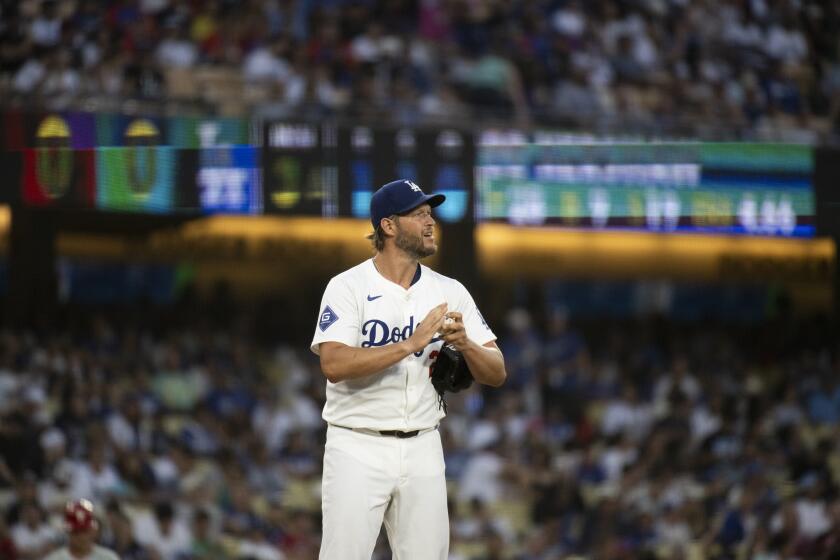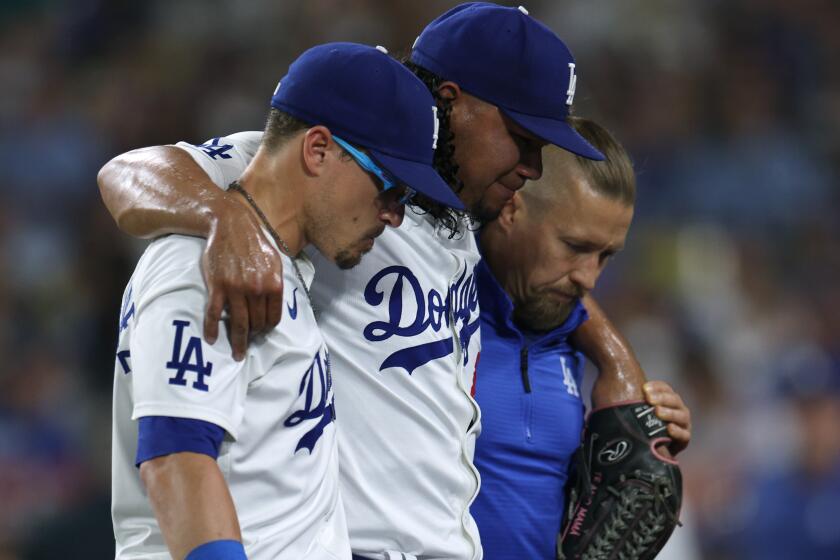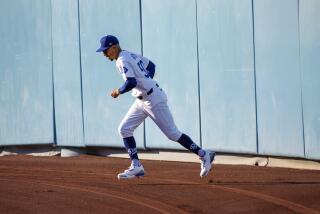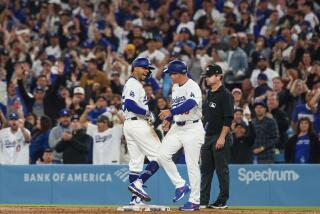Mookie Betts preps for ‘big difference’ as No. 2 hitter; Brusdar Graterol return ‘hopeful’
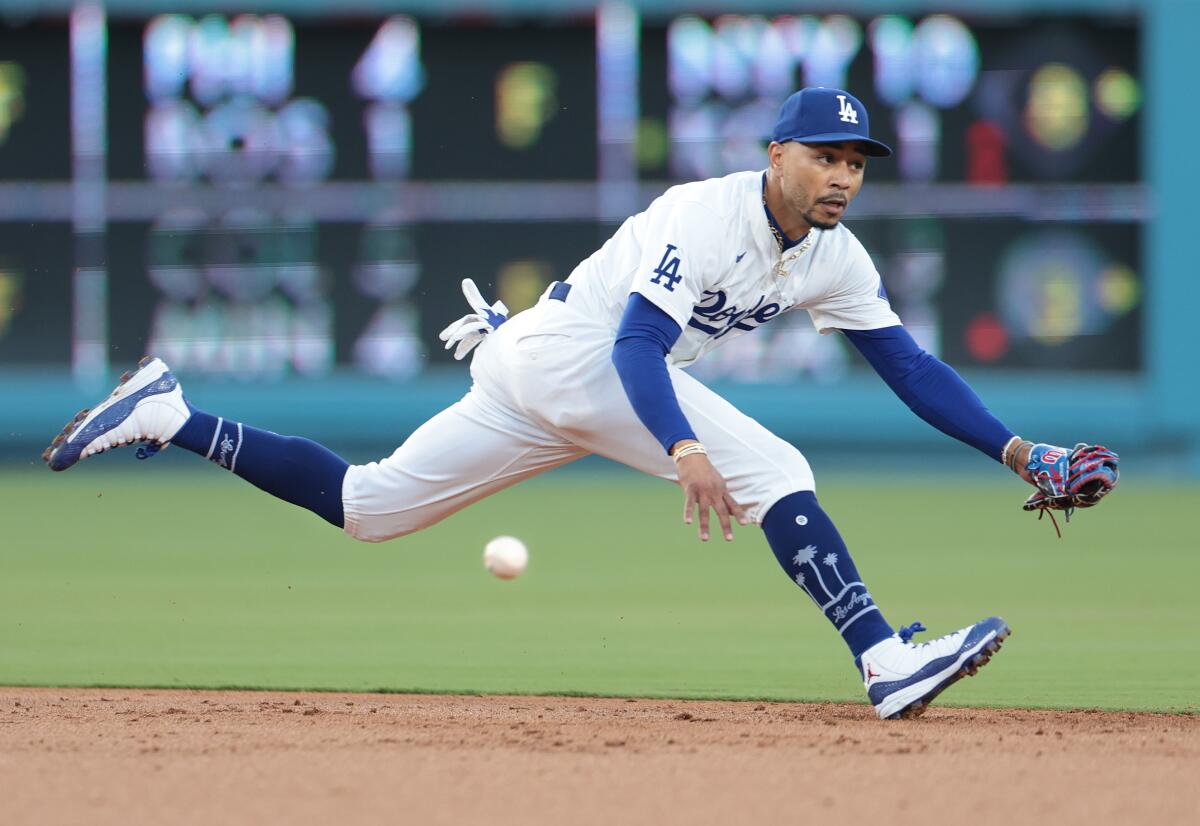
- Share via
For most of the last five seasons, the Dodgers have built themselves around Mookie Betts.
When Betts returns to the Dodgers’ lineup from a broken hand next week, however, he’ll be the one moving in the batting order for someone else.
As he has done since Betts’ injury in mid-June, Shohei Ohtani will remain the Dodgers’ leadoff hitter next week. Betts, for the first time in almost three years, will bat second.
“I mean, I can’t say I’m better than Shohei,” Betts quipped Wednesday. “There’s nothing really you can say. Whatever Shohei says goes, and after that we kind of fall in line.”
As a longtime leadoff hitter with 52 career leadoff home runs (fifth-most in MLB history), Betts acknowledged the change would be an adjustment.
“Yeah, for sure,” he said. “Big difference. Huge difference.”
During an on-field scrum with reporters, however, Betts didn’t outwardly object to the switch.
“When the lights turn on, it doesn’t matter,” he said. “You gotta be ready to go. And I’ll be ready to go.”
Still, it’s the kind of concession Betts hasn’t often had to make during his time in Los Angeles, where he has played a leading role on the Dodgers’ 2020 World Series team and three other 100-win, postseason-bound squads.
Of his 530 career starts with the Dodgers, 507 have come as the leadoff hitter. The last time Betts didn’t bat first was September 2021, after the Dodgers acquired Trea Turner and temporarily had him bat leadoff.
But since Betts suffered his broken hand on a hit-by-pitch June 16, Ohtani has thrived in the leadoff role. While Ohtani’s batting average hasn’t been as high in the No. 1 spot (.292 as the leadoff hitter; .314 batting second), the slugger’s power numbers have gone through the roof, with Ohtani collecting 15 home runs, 35 RBIs and a superb 1.095 OPS in his last 41 games (he had a .976 OPS previously, when he primarily batted second).
“I think that it’s hard to argue Shohei starting the game off in the one,” Roberts said Tuesday. “I just feel that, as great as Mookie is, Shohei really has the chance to change the game from the first pitch.”
Betts will be in a more familiar position defensively when he returns next week, slated to resume his role as the club’s primary shortstop — which he was playing for the first time this year — despite missing important game reps the last two months.
Like with his spot in the lineup, Betts said he didn’t voice a preference about his defensive position while discussing his role with club officials in recent days.
“My tone hasn’t changed,” he said. “I just want to win.”
However, Betts’ enjoyment level playing the infield the last couple of years — after winning six Gold Gloves as a premium right fielder for most of his career — hasn’t gone unnoticed by the club, either, with Roberts confirming it was a factor in the team’s decision to keep him at shortstop for the time being.
“The overarching, most important part of this is you have to put the best players in the best positions that are best for the team,” Roberts said. “I don’t think there’s a player — Mookie in this case — who isn’t aligned with that thought.”
The Dodgers might not like the idea of staking their season on a 36-year-old who underwent a major shoulder operation during the offseason, but the rotation has unraveled.
Roberts said the Dodgers are preserving “optionality” for now, noting that Betts could “always kick out to the outfield” down the road — perhaps for a more sure-handed shortstop like Miguel Rojas come the playoffs.
“It might come to that,” Roberts said. “But like I said, what we don’t want is something unforeseen to happen at the shortstop position, and we tap [Mookie] on the shoulder and say, ‘We need you to go back and play a position you haven’t played in two months.’ I just don’t think that’s the way to do it.”
So, at least initially, Betts will enjoy continuity on defense, while adjusting to a new spot in the batting order.
“I’m confident in my abilities to go play wherever,” Betts said. “And wherever they think is best for the team, I’ll do it.”
Graterol could return after all
On Tuesday night, the Dodgers feared reliever Brusdar Graterol had been lost for the year.
By Wednesday afternoon, however, the right-hander’s prognosis had suddenly improved.
Clayton Kershaw rebounded from a bad outing, but reliever Brusdar Graterol severely injured his hamstring as the Dodgers lost to the Phillies.
Instead of the more severe Grade 3 hamstring strain the Dodgers feared Graterol had suffered in his long-awaited season debut Tuesday night — one that’d been delayed by a spring training shoulder injury — an MRI revealed that Graterol had only suffered a Grade 1 strain, instead.
“Obviously we’re going to go through the process of resting it, rehabbing it and we’re just going to go on him, see how we can build him back up,” Roberts said. “But [we’re] hopeful that he’ll return at some point in time this year.”
Graterol’s injury initially looked serious, with the 25-year-old getting helped off the field with tears in his eyes.
“Early on, obviously, you could see with his emotion that he probably felt that was going to be the season for him,” Roberts said.
But then came Wednesday’s revelation, which Roberts said provided the Dodgers a “sense of relief and some optimism” with their flame-throwing reliever — though any exact timeline for Graterol’s potential return remains unclear.
More to Read
Are you a true-blue fan?
Get our Dodgers Dugout newsletter for insights, news and much more.
You may occasionally receive promotional content from the Los Angeles Times.

